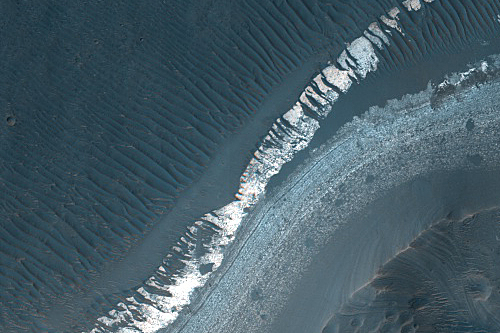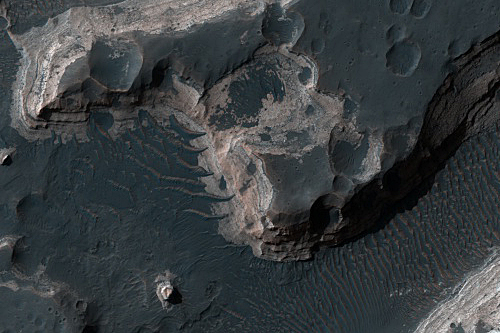Despite what it might look like, this is not the beach of a lakeside resort here on Earth. It’s what remains of a dried up lake on the surface of Mars, yet another fantastic image brought to us by the cameras on the High Resolution Imaging Science Experiment (HiRISE.) This is a closeup of the largest of the “fans” leftover from the lake in the bottom of Holden Crater, an 87-mile (140-kilometer) wide crater in the bottom of the larger Holden Basin on Mars.
What’s interesting about a dried up lake bed, besides the spectacular image? Well, it’s the perfect place to start a search for life on Mars. A nice, calm lake would be a likely place for life to form. This site is one of the six possible landing sites for the NASA’s Mars Science Laboratory, which launches next year and will try to answer the question of whether life on Mars existed at one time, or continues to thrive there.
In addition to the possiblity that the lake was at one time inhabited by Martian life, the crater is full of rocks and sediment that are of interest to geologists studying the history of Mars. Called “megabreccia”, the floor of the crater contains a mixture of boulders, sediment and clay. Before the impact that formed the crater, sediments were deposited in the bottom of Holden Basin by channels of water running across the basin. Blocks of the surface as large as 50 meters (164 feet) across were thrown up when the crater was made.
“When large craters form, they produce very large blocks of material. We see them on Earth. Popigai Crater in Russia is one example. But we’d never seen them on Mars, and we knew they ought to be there. Now we’ve seen them with HiRISE,” said John Grant of the Smithsonian National Air and Space Museum, who is the first author on a paper about Holden Crater recently published in the journal Geology.
The crater’s history is even more complicated: the rim of the crater was breached by surrounding water, creating a massive flood that stirred up the sediments on the bottom and re-filled the crater. Boulders and debris from the event are strewn over the top of the megabreccia, and are also covered in fine sediment and clay that settled on them from the lake before it dried up. The volume of water in this catastrophic flood would have been larger than that contained within Lake Huron.
Both images used here are in false color to help reveal details. This second image shows the layers produced by the impact and subsequent flooding, most noticeable on the walls in the upper left-hand corner. Mars was likely wetter during its early history, and the flow of water later in its life was probably reserved to catastrophic events such as the breach of Holden crater.
Images like this and more have been really pouring in from HiRISE. To see more, check out their site and our coverage here at UT on this fantastic image of an avalanche in progress on Mars, and this picture of the Earth and Moon together in one beautiful shot.



VERY VIOLENT SHIFT TO ONE SIDE AND THEN THE, EXPECTED, RETURN OF THE LARGE SEMI-LIGUID, LATERAL MOTION FOUND WITH A HARD PUSH. VERY IMPORTANT TO GET SAMPLES OF THE WHITE SEDIMENT NEAR THE UNMISTAKEABLE SHORE. THESE MAY HAVE BEEN FORMED BY SUPERHEATING AND THE QUICK RETREAT OF THE FLUID SEA. MAY RENDER WHAT WENT IN THE ATMOSPHERE TO TOXIFY THE ENVIRONMENT AND ESCENTS OF THE FORMER ATMOSPHERE. LOL
COOL that be cool if martians were there and they were like bugs or somthing that live in the holes of mars and come out only at night
THAT MAKES NO SENSE
Would really like to here more from Cecil as it relates to the comments left.
Specifically, what would cause such actions as describe in the posted comments?
its really cool to actually find a dried (LAKE!) on Mars i mean common thats alot of proof that there was life on Mars,hence maybe there is NOW under Mars crust there could be still living there!!!!
Must i say more?
I MAKE MY POINT!..,i hope..
Great pics. Mars Attacks! )
There are some strange facts about the former climate oin mars. The sun was colder long ago than it is now. Still the climate seems to have been warmer om mars several hundred million years ago, and also on earth.
Perhaps Mars and Earth at that time had some other warming process, for example interior heating.
There are some strange facts about the former climate oin mars. The sun was colder long ago than it is now. Still the climate seems to have been warmer om mars several hundred million years ago, and also on earth.
Perhaps Mars and Earth at that time had some other warming process, for example interior heating.
Or perhaps there were more greehouse gasses in the ethmosphere at former times.